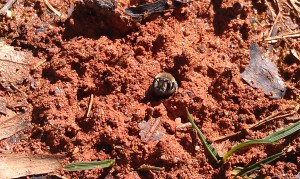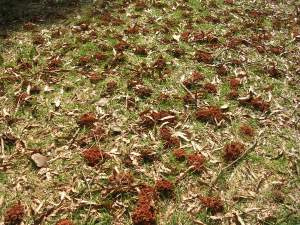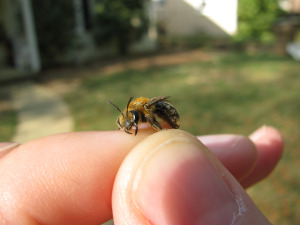Pest Alert: Ground Bees Active but Do Not Threaten People or Yards
go.ncsu.edu/readext?282715
en Español / em Português
El inglés es el idioma de control de esta página. En la medida en que haya algún conflicto entre la traducción al inglés y la traducción, el inglés prevalece.
Al hacer clic en el enlace de traducción se activa un servicio de traducción gratuito para convertir la página al español. Al igual que con cualquier traducción por Internet, la conversión no es sensible al contexto y puede que no traduzca el texto en su significado original. NC State Extension no garantiza la exactitud del texto traducido. Por favor, tenga en cuenta que algunas aplicaciones y/o servicios pueden no funcionar como se espera cuando se traducen.
Português
Inglês é o idioma de controle desta página. Na medida que haja algum conflito entre o texto original em Inglês e a tradução, o Inglês prevalece.
Ao clicar no link de tradução, um serviço gratuito de tradução será ativado para converter a página para o Português. Como em qualquer tradução pela internet, a conversão não é sensivel ao contexto e pode não ocorrer a tradução para o significado orginal. O serviço de Extensão da Carolina do Norte (NC State Extension) não garante a exatidão do texto traduzido. Por favor, observe que algumas funções ou serviços podem não funcionar como esperado após a tradução.
English
English is the controlling language of this page. To the extent there is any conflict between the English text and the translation, English controls.
Clicking on the translation link activates a free translation service to convert the page to Spanish. As with any Internet translation, the conversion is not context-sensitive and may not translate the text to its original meaning. NC State Extension does not guarantee the accuracy of the translated text. Please note that some applications and/or services may not function as expected when translated.
Collapse ▲Steve Frank, Extension Entomologist, NC State University
As I write this my front yard is abuzz with small bees. Many are flying around just above the ground while others fly back and forth to redbuds and camellias gathering pollen.
Although these bees do not generally sting I watch as mothers nervously cross the street with strollers. Neighbors pass by and comment “Watch out for all those fire ants” referring to the small mounds that dot my sparsely vegetated lawn. Others offer suggestions on how to rid myself of these dangerous beasts that are “tearing up your lawn.”

Bee emerging from its mound. Photo: S. D. Frank.
The bees I am watching are ground nesting bees in the family Andrenidae. All the species in this family are solitary and nest in the ground. Solitary means they do not maintain vast hives with hundreds of workers like honey bees or yellow jackets. A single female bee builds the nest by burrowing into the ground. She prepares larval cells where eggs will be laid. Mothers provision each brood cell with a mixture of pollen and nectar called bee bread that serves as food for young larvae. After laying an egg she closes the brood cell and starts another. After completing several brood cells the mother will seal the entrance and leave the nest to begin a new nest. After a few weeks she will die leaving the next generation safe in the ground. In spring bees complete development and emerge as adults that dig their way out of the ground and forage for pollen and nectar to provision their own nests. The visual spectacle of these bees is produced largely by males who swarm over nests trying to mate with newly emerged females. The other noticeable aspect of these bees is the small mounds of dirt excavated for each nest.

Hundreds of small mounds created by bees emerging from underground nests and females bees digging new nests.
Hundreds of small mounds and swarms of bees often trigger calls to exterminators or landscape professionals. Homeowners fear that they will be attacked and stung as they bend over to pick up the paper and they believe that the bees are actively damaging their yard and want them gone. This is not the case.
An ovipositor is the organ female insects use to insert eggs into substrates such as leaves, wood, soil, other insects, or in our case brood cells. In social insects such as honeybees, most of the females are workers that do not mate or lay eggs and thus have no need for an ovipositor. However, they do need to protect the nest from invaders. Therefore, the ovipositor of these species has evolved into a stinger to ward off threats.

Bee held safely for a portrait. Photo: S. D. Frank.
With this in mind it is easy to understand why the threat of being stung by the ground nesting bees in my yard is so small. First, the bees swarming around are mostly males. Males don’t lay eggs and thus do not have an ovipositor modified or otherwise. The female bees are responsible for all aspects of nest construction and provisioning and are busy digging and foraging. Since the ovipositor of ground nesting bees is necessary for laying eggs, it is not well developed as a stinger if at all. I won’t say that you will never be stung because this would encourage some fool to torment bees until they proved me wrong. However, I have handled these bees quite a bit and never been stung.
These bees prefer to nest in dry, sparsely vegetated areas. Therefore if you have bees nesting in your lawn it is because the grass is thin and soil dry. The bees don’t make it this way they just take advantage of the conditions. If anything the bees are providing a valuable service by aerating the lawn!
The behavior and habitat preference of these bees leads us to the most promising ways to reduce their abundance in a particular yard. First they like dry soil they can dig nests in. Therefore, irrigation over the 3-4 weeks bees are active will encourage them to find other nest sites and reduce their abundance the following year. In addition, they like thin lawns with plenty of bare spots. Thus, you can take measures to improve the density of your grass to make it less appealing to bees. Native bees are an important part of ecosystems and food production. We should take steps to protect these bees or at least use non-lethal means to encourage them to nest somewhere else.


